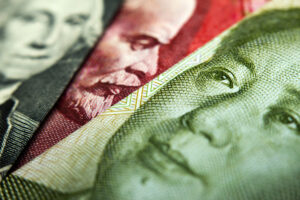Russia Dropping US Dollar for Chinese Yuan—And Fast
The comments below are an edited and abridged synopsis of an article by Ben Norton
In response to Western sanctions, Russia is dropping the US dollar and will buy Chinese yuan instead. The yuan’s share of Moscow’s currency trading increased from 1% to 40-45% in 2022, while dollar trade halved from 80% to 40%.
Russia has spent years decreasing its dependency on the dollar, but especially since the escalation of the war in Ukraine, Moscow has accelerated its drive toward de-dollarization.
Western sanctions have locked Russia out of the US-dominated international financial architecture. Numerous Russian banks were disconnected from the SWIFT inter-bank messaging system. A staggering $300 billion of the Russian central bank’s foreign exchange reserves were frozen.
The yuan has replaced the dollar as the most sought-after foreign currency in Moscow. The dollar is involved in around 80% of global trade, and it makes up approximately 60% of globally disclosed official foreign reserves, as of 2021.
But geopolitical conflict has pushed Russia, China, Iran and others to begin de-dollarizing, or diversifying their foreign reserves. Russia has already made importers of its oil and gas pay in rubles, a challenge to the petrodollar.
Russia has become the world’s 4th-largest offshore trading center for renminbi; a drastic change, considering it was not even in the top 15 at the beginning of 2022.
In March, the IMF warned of an erosion of dollar dominance. It noted that use of yuan in global central bank reserves has increased, while dollar holdings declined from roughly 70% in year 2000 to less than 60% by 2021.
Western sanctions on Russia have also incentivized countries around the world to create new financial systems for regional trade in other currencies—not just adversaries, but also allies such as India, Egypt and Saudi Arabia.
In July, Russian President Vladimir Putin visited Iran, where the two countries signed a $40 billion energy cooperation agreement, and pledged to deepen their economic integration. They called for a challenge to the dominance of the dollar, instead proposing the use of local currencies for trade.

